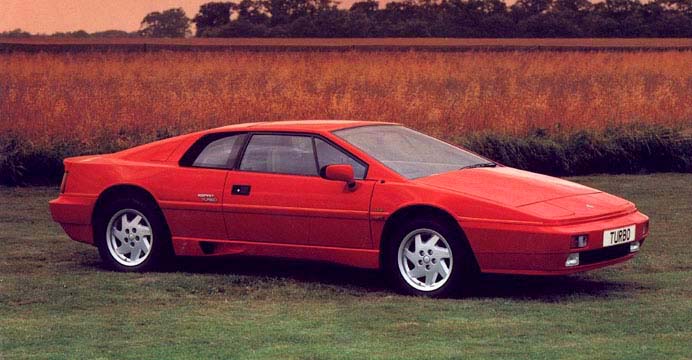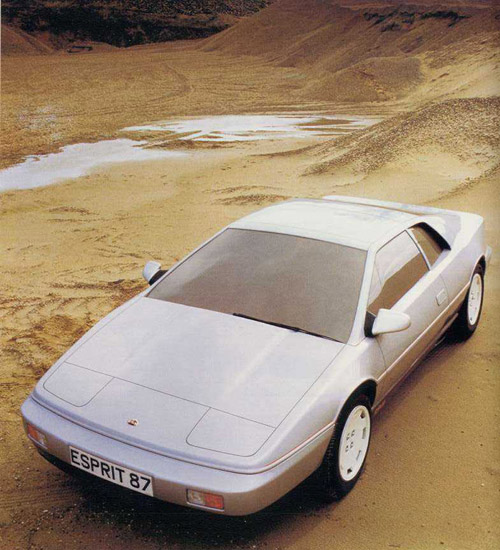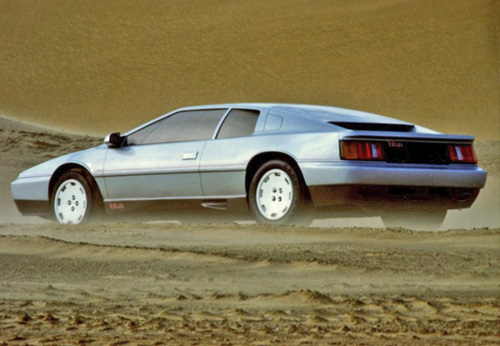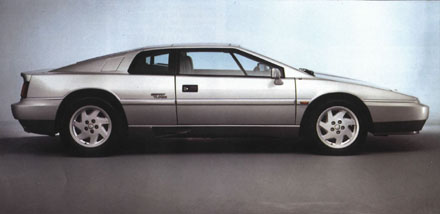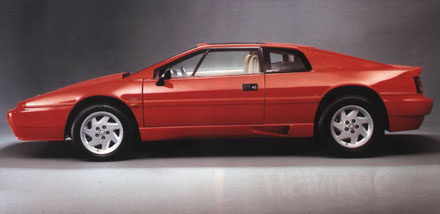
In 1987 everything looked rosy for Lotus. The first prototypes of a new smaller front-engined car, to be called Elan when launched, had gone on the road, Group Lotus had made more than £2 million profit for General Motors and a restyled Esprit was announced. The new style car, coded X180 at Hethel, was launched in October 1987, with deliveries beginning almost at once. Because this was merely a new bodyshell on an existing and well proven chassis, with a new gearbox/transaxle, this was an excellent, low investment way of developing a new model. The progress from concept to production had taken only 15 months.

In October 1987 Lotus dropped the original Giugiaro styled Esprit and replacing it with a restyled car, designed by Peter Stevens. The new car was much more rounded and every panel and piece of glass had been changed, yet its overall profile was very similar indeed.
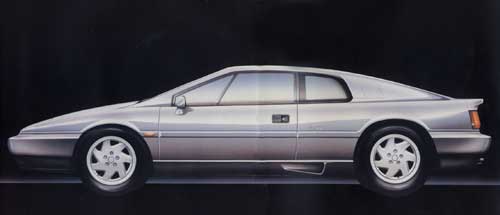
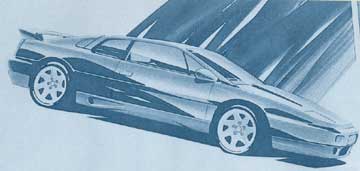
Compared with the now obsolete and sharper edged Giugiaro style, the X180 was more rounded, smoother and softer than before.
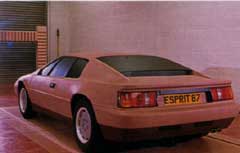
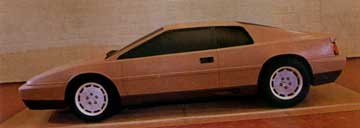
Compare these two side on studies, and you should be able to pick one X180 styled Esprit from the other, though the differences are small. The car above is the Turbo version, complete with Esprit Turbo badges behind the doors, while below is the normally aspirated model, which carries its Esprit badges below the rear quarter window. Note the Lotus Design badge ahead of the door pillars.
The aerodynamic impression of shapes, incidentally, can be deceptive. Although the new car looked much smoother than before, its drag coefficient was in fact slightly higher, at 0.35 instead of 0.34. Cohn Spooners team of designers, led by Peter Stevens, had solved a near impossible task with great style. The aggressively sharp edged Giugiaro design which had been truly in vogue in the Seventies but had been outdated by design trends in the Eighties, was replaced by something more sensuous, more gently rounded and more sophisticated yet it sat on the same backbone chassis, with the same wheelbase and track dimensions. As with other modem Lotuses, the new style was designed to be produced in two large halves, top and bottom, mainly from glassfibre, but with some local Kevlar reinforcement, using the companys patented vacuum-assisted resin injection (VARI) process. The style was created in house, at Hethel. Giorgetto Giugiaro, I understand, was not asked to offer ideas, and probably never even saw the new shape until it was unveiled.
1987 Lotus Esprit Turbo X180 - Click on image to enlarge
1987 Lotus Esprit Normally Aspirated - Click on image to enlarge
Two more studies of the X180 Esprit. This is the normally aspirated model (right), as introduced in the autumn of 1987, with what was know as the open back body style between the two sail panels on the rear quarters. While the 1988 model Esprit Turbo (left), which had a glass back feature between the sail panels, and a different rear lower body moulding and cooling grills arrangements. Although the profile of the new body varied by no more than an inch from the old at any point, it looked very different. All key lines were rounded off, rather than razor sharp, most details such as the fuel-filler flap, and the air scoops for the engine bay, which were in the sill mouldings ahead of the rear wheels, were much tidier than before, front and rear bumpers were made in knock-resistant mouldings, and, in spite of initial impressions, every single pane of glass was a new shape and size. The new body featured a lift out panel in the roof, this being either in a Nomex honeycomb material, or in tinted glass.
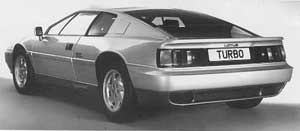
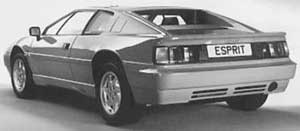
There were several basic visual differences between the normally aspirated and the turbocharged types. Each car had its own special type of cast alloy road wheel, though the same tyres were shared between types, while the Turbos front end had extra driving lamps and a different front end air intake. The biggest and most obvious difference was clear from the three quarter rear aspect. Both types of car featured neatly detailed flying buttress panels from the rear of the doors to the flip-up spoiler on the tail, but only the turbocharged car filled in most of that recess with a large sheet of glass to give what Lotus claimed was a tunnel back feel. The Turbo also had a different rear lower body, with a carefully profiled under tray/spoiler to act as a scoop to help extract hot air from the engine bay and the brakes. Like the last versions of the Giugiaro-styled Esprit of 1975 to 1987, the X180 Esprit had reclining seat backs. However, as can be seen here, most of the time the seats would be pushed back hard against the bulkhead, giving no scope for the backrests to be reclined. Note the fixings for the glass roof panel. Inside the car there was significantly more legroom and passenger space in general, but this was still a small two-seater coupe cabin because there was a limit to what Grand Prix designer John Cooper would call the Albert Hall effect which could be achieved. Instruments and the panel were new, there was a better ventilation system, which was sorely needed, as all hot climate Esprit owners would no doubt agree, yet this was still not a car in which tall, particularly well-built drivers could get comfortable.

The X180 Esprit had a new type of instrument panel and facia, though the general layout and features were familar. The footwell package was more spacious than before, but all such improvements were relative, as it still helped to have small feet and relatively short legs. Facelifts, in general, do not always work very well, but the X180 process was in any case much more than a mere facelift. It was a complete restatement of the Lotus mid engined theme, and it worked out extremely well. The designers had worked round the car in great detail, producing a neater and more integrated solution to almost every task. The new car looked so good that it was a temptation to go back to the old type, criticize slots, flaps, lines and features and say to oneself: How could we ever have put up with that? It was not heresy, but of how many other Giugiaro designs would one even begin to be critical? Though little could be done about the overall size of the two seater cockpit, particularly as no changes had been made to the central backbone, or to the height of the chassis pressings, the view from the drivers seat was little different from before. There was a new and more integrated facia design dominated by VDO instruments, the roof panel could be removed, though surprisingly few owners seemed to take advantage of this feature and improvements had been made to the ventilation system.
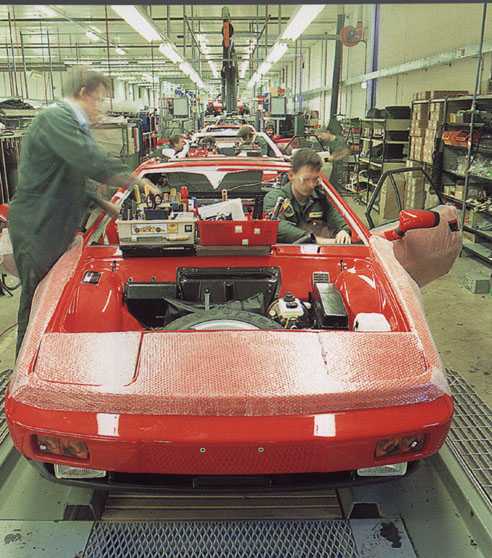
Mechanically the new shape Esprits were very similar to those of the 1986 to 1987 HC models which had just been made obsolete, which is to say that for normally aspirated cars the 172bhp engine was standardized, while for the Turbo there were two different types, one with Dellorto carburettors, the other with Bosch K Jetronic fuel injection. There was one major exception, but only on non Federal market cars at first. Instead of the familiar Citroen/Maserati type of five speed gearbox, Lotus had to find a replacement that would fit, which was robust enough and suitably packaged. Because the number of powerful European cars with combined gearbox/final drive transaxles was increasing all the time, Lotus had no trouble in finding a new supply. Links with Renault of France, which had flourished in the Sixties in the case of the mid engined Europa, were revived, and Lotus chose the robust Renault 25/Renault GTA type of five-speeder instead of the old Citroen type. Surprisingly, though, the Citroen gearbox was retained on USA market Esprit Turbo HCPIs for the first year or so. The old Citroen gearbox had served Lotus well and was still available from France, but all the mainstream Citroen! Peugeot models which had used it had dropped out of production. Soon, Lotus reasoned, the French company might want to close down supplies. The 25/GTA-type gearbox, on the other hand, was relatively modern, and had an assured future. This gearbox, incidentally, was a very versatile unit. In the sporting GTA itself it was arranged to be ahead of the final drive unit, and driving back to it. In the Renault 25, it was behind the line of the final drive, and driving forward to it! For the new Esprit, therefore, where the gearbox was behind the final drive, there were strong similarities to the Renault 25 type of installation. There was one other significant mechanical change, which was forced upon Lotus. When Renault were developing the new gearbox, they had decided to use outboard disc brakes on their cars. Accordingly, there was no way that Lotuses inboard discs could be fixed to the new casing. The old Esprit, therefore, had always used inboard disc brakes, fixed to a Citroen transmission intended for such a fitting; the new car had outboard discs for the very first time.
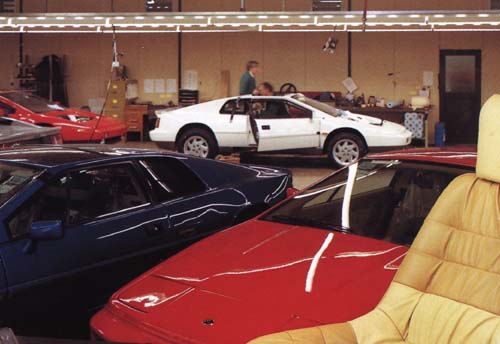
Clearly the Esprit restyle had arrived at exactly the right moment. Backed by the might of General Motors, Lotuses self confidence was glowing as never before, and they had recently acquired control of the Lotus sales/distribution organization in the USA. This was moved from New Jersey (west of New York) to a brand-new facility at Atlanta, Georgia.The company was making good profits, the still secret new Elan was on the way and sales shot up. At the London Motorfair in October 1987 Lotus announced that they had taken orders for 371 Esprit Turbos, worth £8.2 million. In 1987 a total of 462 Esprits, new type and old type combined, had been produced, but helped along by the new style this total rose to no fewer than 1,058 in 1988, which was easily an Esprit record. In fact this was an all time Esprit record, for although there would be another major new development in 1989, Lotus never again built more than 1,000 Esprits in a year.In the first half of 1988 UK sales totalled 271 cars, while exports rose to 311, of which no fewer than 172 went to the USA. At the end of 1988 those figures had risen to 572 UK sales and 323 USA sales.
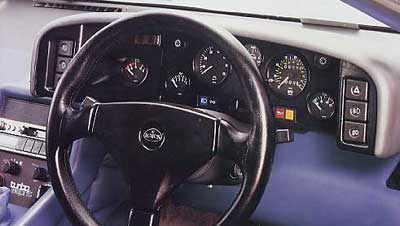
The new style Turbo was a genuine 150mph car and this, allied to overall fuel consumption of around 20mpg (Imperial), made the latest car an intriguing proposition. Purists still complained about the restricted cockpit space, the need for power assisted steering and the fact that the car did not have ABS anti lock braking, but even they could drive the Esprit faster than almost every other supercar, and still arrive at the end of a trip with a big smile on their faces As Autocar testers wrote in April 1988: The Esprit Turbo has many points in its favour. Searing performance, a chassis and brakes to match and sensational looks are only part of it. You also get acceptable fuel economy, a fine ride with very little road noise and reasonable luggage space for a two seater By supercar standards, the Esprit Turbo is something of a bargain.
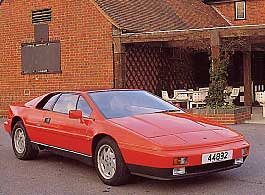
Taken from Lotus Since the 70s by Graham Robson
